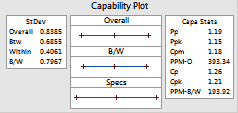|
|
Capability Sixpack - Between/WithinGraphs - Overall Capability Indices |
The overall capability section includes capability indices associated with the overall sample standard deviation.
The industry guidelines determine whether the process is capable. A generally accepted minimum value for the indices is 1.33.
These indices depict how the process is actually performing relative to the specification limits. The capability indices consist of the following:
Note that Ppk considers the location of the process mean, while Pp does not. If Pp and Ppk are approximately equal, then the process is centered between the specification limits. If Pp is greater than Ppk, then the process is not centered.
A substantial difference between the overall and B/W capability indices may indicate that the process is out of control. For the coating data, the B/W and overall capability indices are very close to each other.
Example Output |

Interpretation |
For the coating data, Pp = 1.19, which indicates that the specification spread is 1.19 times greater than the 6-s spread in the process.
Pp (1.19), Ppk (1.15), and Cpm (1.18) are very close to one another, indicating that the process is centered on target. Thus the process is centered on target and is capable of producing pistons that conform to specifications. PPM-O is 393.34, which indicates that 393.34 parts out of one million parts are nonconforming.